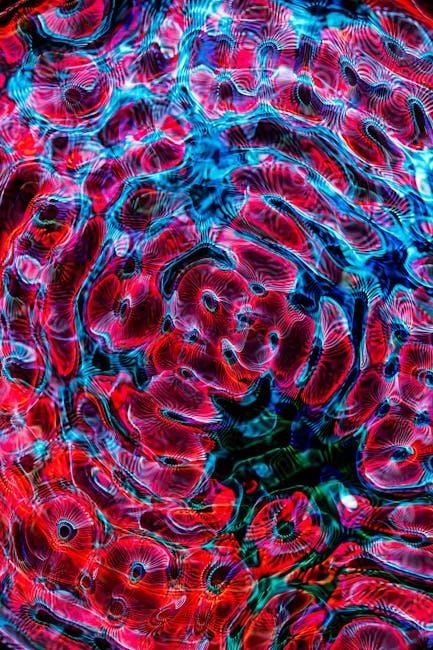Mass Spectrometry PDF: A Comprehensive Guide
Mass spectrometry is a powerful analytical technique used for identifying substances by sorting gaseous ions based on their mass-to-charge ratios. This comprehensive guide offers an in-depth exploration, covering principles, instrumentation, applications, and data interpretation.
Mass spectrometry (MS) stands as a pivotal analytical technique, revolutionizing diverse scientific fields through its ability to measure the mass-to-charge ratio of ions. This capability allows for the identification and quantification of various molecules within complex mixtures.
The technique’s versatility extends to analyzing biomolecules, ranging from small metabolites to large proteins, making it indispensable in proteomics, metabolomics, and drug discovery. Its applications span across environmental monitoring, food safety, and clinical diagnostics, highlighting its broad utility.

At its core, MS involves ionizing a sample, separating the resulting ions based on their mass-to-charge ratio, and detecting their abundance. The resulting data, presented as a mass spectrum, provides a unique fingerprint for each compound, enabling identification and quantification.
This introduction serves as a gateway to understanding the fundamental principles, instrumentation, and applications of mass spectrometry, paving the way for a deeper exploration into this powerful analytical technique.
Basic Principles of Mass Spectrometry
Mass spectrometry operates on the fundamental principle of separating ions based on their mass-to-charge (m/z) ratio. Unlike neutral species, ions are easily manipulated and detected, making them ideal for mass analysis. The process begins with ionization, where neutral molecules are converted into charged ions, typically in the gas phase.
These ions are then accelerated through an electric field and directed into a mass analyzer. The mass analyzer separates the ions according to their m/z ratio, using magnetic or electric fields, or time-of-flight principles. Upon separation, the ions are detected, and their abundance is measured, generating a mass spectrum.
The mass spectrum plots the intensity of each ion signal against its corresponding m/z value, providing a unique fingerprint of the analyzed compound. This fingerprint can be used to identify the compound, determine its molecular weight, and elucidate its structure.
Understanding these basic principles is crucial for interpreting mass spectra and applying mass spectrometry to various analytical challenges. The technique’s sensitivity and versatility make it an invaluable tool across diverse scientific disciplines.
Ionization Methods in Mass Spectrometry
Ionization is a crucial step in mass spectrometry, converting neutral molecules into ions for subsequent analysis. Several ionization methods exist, each suited for different types of analytes. Electron ionization (EI) is a common technique, particularly for volatile compounds, where molecules are bombarded with electrons, leading to ionization and fragmentation.
For larger, more fragile molecules, electrospray ionization (ESI) is often preferred. ESI involves spraying a liquid sample through a charged needle, producing charged droplets that evaporate, leaving behind multiply charged ions. Another soft ionization technique, matrix-assisted laser desorption/ionization (MALDI), is widely used for biomolecules.
In MALDI, the analyte is mixed with a matrix compound and irradiated with a laser, causing ionization and desorption of the analyte. Chemical ionization (CI) involves reacting the analyte with reagent ions, leading to ionization through proton transfer or adduct formation.
The choice of ionization method depends on the analyte’s properties and the desired information. Each method has its advantages and limitations, influencing the fragmentation pattern and the types of ions produced. Understanding these ionization techniques is essential for effective mass spectrometry analysis.
Mass Analyzers: Types and Functionality
Mass analyzers are core components of mass spectrometers, responsible for separating ions based on their mass-to-charge ratio (m/z). Several types of mass analyzers exist, each with unique principles and performance characteristics. These analyzers play a critical role in determining the resolution, sensitivity, and mass accuracy of the mass spectrometer.
Quadrupole mass analyzers use oscillating electric fields to selectively filter ions based on their m/z values. Time-of-flight (TOF) analyzers measure the time it takes for ions to travel through a field-free region, with lighter ions arriving at the detector faster than heavier ions. Magnetic sector analyzers use magnetic fields to deflect ions, separating them based on their m/z ratios.
Ion trap mass analyzers, such as quadrupole ion traps and Orbitraps, trap ions and manipulate their motion to determine their m/z values. Each type of mass analyzer offers different advantages in terms of resolution, mass range, and scan speed. Hybrid instruments combine different mass analyzers to achieve enhanced performance and versatility.
The selection of a mass analyzer depends on the specific application and the desired analytical capabilities. Understanding the principles and functionality of different mass analyzers is essential for optimizing mass spectrometry experiments.
Quadrupole Mass Analyzer
The quadrupole mass analyzer is one of the most widely used types of mass analyzers in mass spectrometry. It consists of four parallel cylindrical rods, arranged in a square array. Opposite rods are electrically connected, and a combination of radio frequency (RF) and direct current (DC) voltages are applied to the rods.
Ions enter the quadrupole field and oscillate along their trajectory. The applied voltages create a potential field that allows ions of a specific mass-to-charge ratio (m/z) to pass through the analyzer, while others are destabilized and collide with the rods. By scanning the applied voltages, ions of different m/z values can be selectively transmitted to the detector.
Quadrupole mass analyzers offer several advantages, including relatively low cost, compact size, and ease of operation. They are commonly used in GC/MS and LC/MS systems for a wide range of applications. Quadrupoles typically offer unit mass resolution, meaning they can distinguish between ions with integer mass differences.
They are known for their robustness and ability to handle high ion currents. The performance can be optimized by adjusting the RF and DC voltages, as well as other parameters. The limitations include lower resolution compared to other analyzers.
Time of Flight Mass Analyzer
The Time-of-Flight (TOF) mass analyzer separates ions based on their time it takes to travel through a field-free region. Ions are accelerated by an electric field, giving them kinetic energy proportional to their charge. Since all ions receive the same kinetic energy, their velocity depends on their mass.
Lighter ions travel faster and reach the detector sooner than heavier ions. The time of flight is precisely measured, and the mass-to-charge ratio (m/z) is calculated based on this time. TOF analyzers offer high sensitivity and the ability to measure a wide range of m/z values simultaneously.
Reflectron TOF instruments improve resolution by compensating for variations in initial kinetic energy. These instruments use an ion mirror to reflect ions back towards the detector, correcting for differences in path length due to slight energy variations. TOF mass analyzers are commonly coupled with MALDI ionization sources for proteomics and polymer analysis.
They are also used in atmospheric pressure ionization techniques. TOF analyzers are known for their high mass accuracy and ability to analyze large biomolecules. Their limitations include sensitivity to initial ion energy spread and potential for matrix interference.
Magnetic Sector Mass Analyzer
Magnetic sector mass analyzers separate ions based on their momentum as they traverse a magnetic field. Ions are accelerated through a defined voltage, imparting a known kinetic energy. As ions enter the magnetic field, they experience a force perpendicular to their direction of motion, causing them to follow a curved path.
The radius of curvature is proportional to the ion’s momentum and inversely proportional to the magnetic field strength. By varying the magnetic field, ions with different mass-to-charge ratios (m/z) are selectively focused onto a detector. Magnetic sector instruments offer high resolution and mass accuracy, making them suitable for isotopic analysis and precise molecular weight determination.
Double-focusing instruments combine magnetic and electric sectors to improve resolution further. The electric sector focuses ions based on their kinetic energy, reducing the energy spread before they enter the magnetic sector. This combination minimizes peak broadening and enhances the separation of ions with closely related m/z values.
Magnetic sector analyzers are robust and can handle high ion currents, but they are relatively large and expensive compared to other types of mass analyzers. They are often used in specialized applications requiring high performance.
The Mass Spectrum: Interpretation and Data Analysis
A mass spectrum is a visual representation of the data acquired from a mass spectrometer. It plots the relative abundance (intensity) of ions as a function of their mass-to-charge ratio (m/z). The x-axis represents the m/z values, while the y-axis represents the ion abundance, often normalized to the most abundant ion (base peak).

Interpreting a mass spectrum involves identifying the molecular ion peak (M+), which corresponds to the intact molecule with a single charge. Fragmentation patterns provide valuable structural information. Fragment ions arise from the breaking of chemical bonds within the molecule during ionization. The masses of these fragments reveal the building blocks of the original molecule.
Isotopic abundance also plays a crucial role. Elements like chlorine and bromine have characteristic isotope ratios that produce distinct patterns in the mass spectrum, aiding in compound identification. Data analysis often involves comparing the experimental spectrum to spectral libraries or using software to predict fragmentation pathways.
High-resolution mass spectrometry allows for accurate mass measurements, enabling the determination of elemental composition. This information, combined with fragmentation patterns, provides a powerful tool for elucidating the structure of unknown compounds.
Applications of Mass Spectrometry
Mass spectrometry boasts a wide array of applications across diverse scientific fields due to its sensitivity, accuracy, and ability to analyze complex mixtures. In proteomics, it identifies and quantifies proteins, unraveling biological processes and disease mechanisms. Pharmaceutical companies use mass spectrometry for drug discovery, development, and quality control, ensuring drug safety and efficacy.
Environmental monitoring relies on mass spectrometry to detect and quantify pollutants in air, water, and soil, safeguarding environmental health. In food science, it analyzes food composition, detects contaminants, and ensures food safety. Clinical diagnostics utilizes mass spectrometry for newborn screening, disease diagnosis, and therapeutic drug monitoring, improving patient care.
Forensic science employs mass spectrometry for identifying unknown substances at crime scenes, aiding in criminal investigations. Geochemistry benefits from mass spectrometry for dating geological samples and understanding Earth’s history. The petrochemical industry uses it to analyze crude oil composition and optimize refining processes.
These are just a few examples showcasing the versatility and impact of mass spectrometry in advancing scientific knowledge and addressing real-world challenges. Its ability to provide detailed molecular information makes it an indispensable tool in numerous disciplines.

GC/MS: Gas Chromatography-Mass Spectrometry
Gas Chromatography-Mass Spectrometry (GC/MS) is a powerful analytical technique that combines the separation capabilities of gas chromatography (GC) with the identification and quantification capabilities of mass spectrometry (MS). GC separates volatile and semi-volatile compounds in a mixture based on their boiling points and affinity for the stationary phase. The separated compounds then enter the mass spectrometer, where they are ionized and fragmented.

The mass spectrometer analyzes the mass-to-charge ratio of the ions, generating a unique mass spectrum for each compound. By comparing these spectra to libraries of known compounds, GC/MS can identify and quantify the components of complex mixtures. This technique is widely used in various fields, including environmental monitoring, food safety, forensics, and pharmaceutical analysis.
In environmental monitoring, GC/MS identifies and quantifies pollutants in air, water, and soil samples. In food safety, it detects pesticide residues, contaminants, and adulterants in food products. Forensic scientists use GC/MS to identify drugs, explosives, and other substances found at crime scenes. Pharmaceutical companies employ GC/MS for drug development, quality control, and analyzing drug metabolites.
The combination of GC’s separation power and MS’s identification capabilities makes GC/MS an indispensable tool for analyzing complex mixtures and solving a wide range of analytical challenges.
Imaging Mass Spectrometry (IMS)
Imaging Mass Spectrometry (IMS) is a cutting-edge analytical technique that combines mass spectrometry with spatial resolution, enabling the visualization and identification of molecules directly within a sample’s native environment. Unlike traditional mass spectrometry, which analyzes homogenized samples, IMS preserves the spatial context of molecules, providing valuable insights into their distribution and interactions within tissues, cells, or materials. This technique involves ionizing molecules directly from the sample surface and then analyzing their mass-to-charge ratio to generate a mass spectrum at each spatial location;
By rastering the ion source across the sample surface and acquiring mass spectra at each point, IMS creates a molecular map that reveals the spatial distribution of various compounds. This information can be used to study biological processes, disease mechanisms, drug distribution, and material composition.
IMS has a wide range of applications in fields such as biomedicine, materials science, and forensics. In biomedicine, IMS is used to study the spatial distribution of lipids, proteins, and metabolites in tissues, providing insights into disease development and progression. It also aids in drug discovery by visualizing drug distribution and metabolism within target tissues.
In materials science, IMS is used to analyze the composition and distribution of elements and molecules within materials, aiding in the development of new materials with desired properties. In forensics, IMS can be used to analyze trace evidence and create spatial maps of drug distribution within biological samples.
Mass Spectrometry in Proteomics
Mass spectrometry (MS) has become an indispensable tool in proteomics, revolutionizing the way scientists study proteins and their functions. Proteomics, the large-scale study of proteins, aims to understand the structure, function, and interactions of the entire protein complement of a cell, tissue, or organism. Mass spectrometry plays a central role in identifying and quantifying proteins, as well as characterizing their post-translational modifications (PTMs).
In proteomics workflows, proteins are typically digested into peptides using enzymes such as trypsin. These peptides are then analyzed by mass spectrometry, which measures their mass-to-charge ratios. By comparing the measured masses to databases of known protein sequences, the identity of the original proteins can be determined.
Furthermore, mass spectrometry can be used to quantify the abundance of proteins in a sample. This can be achieved through techniques such as isotope labeling or label-free quantification, which allow for the relative or absolute quantification of proteins.
Mass spectrometry is also crucial for identifying and characterizing PTMs, which are chemical modifications that occur on proteins after they are synthesized. PTMs play a critical role in regulating protein function, localization, and interactions. Mass spectrometry can be used to identify the sites of PTMs and determine their abundance, providing insights into the dynamic regulation of protein activity.
Troubleshooting and Optimization in Mass Spectrometry
Mass spectrometry (MS) is a powerful analytical technique, but it can be susceptible to various issues that affect data quality and instrument performance. Effective troubleshooting and optimization are essential for obtaining reliable and accurate results. This section addresses common problems encountered in MS and provides strategies for resolving them.
One common issue is poor sensitivity, which can result from low analyte concentrations, inefficient ionization, or detector problems. Increasing sample concentration, optimizing ionization parameters, or cleaning the ion source can often improve sensitivity. Background noise can also obscure signals. Reducing chemical noise through proper sample preparation and optimizing instrument settings is crucial.
Mass accuracy is another critical aspect. Calibration errors, mass analyzer drift, or unresolved isobaric interferences can lead to inaccurate mass measurements. Regular calibration using appropriate standards and careful selection of mass analyzer parameters are essential.
Furthermore, sample contamination can introduce unwanted ions and suppress analyte signals. Using high-purity solvents, cleaning glassware thoroughly, and implementing proper handling procedures can minimize contamination. Matrix effects, where the sample matrix influences ionization, can also impact accuracy. Standard addition or matrix-matched calibration can help mitigate matrix effects.
Finally, proper instrument maintenance, including regular cleaning and replacement of worn parts, is crucial for optimal performance.
